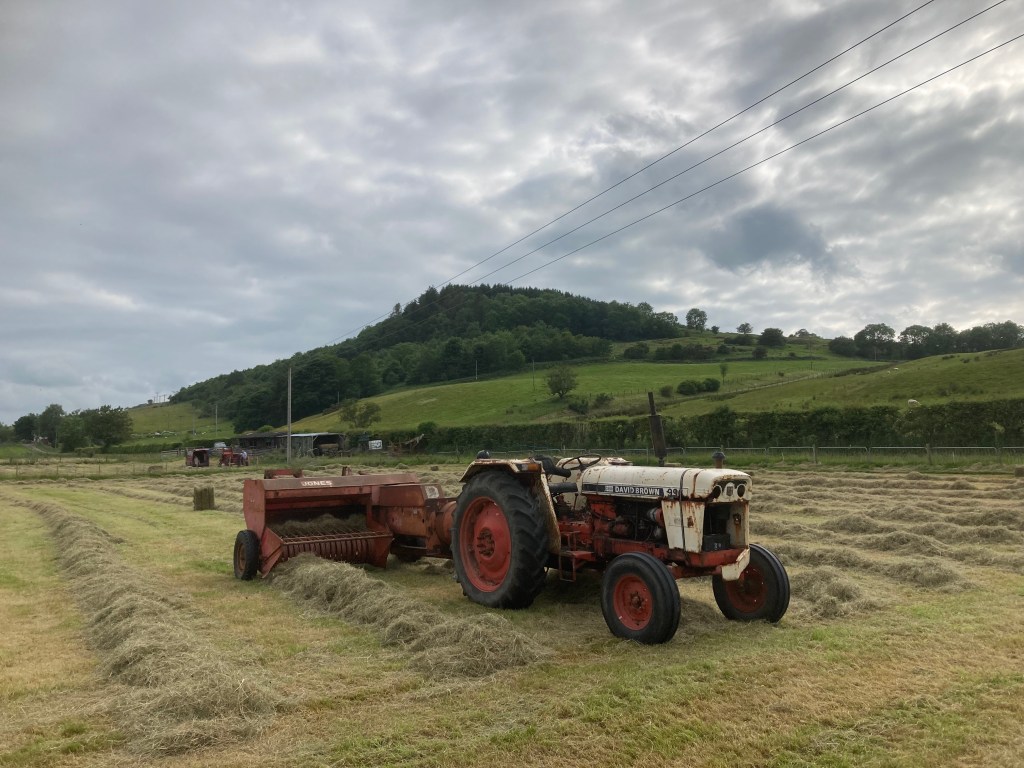
Back in May when the rain fell in sheets for three consecutive days, I watched the silage mowers working into the darkness. The grass was rich and sodden then; a fine and glassy blue to the far horizon. When the crop was mown, forage harvesters growled in the headlights after dark and tall-sided wagons carted the grass away to concrete pits for storage.
I always used to think that silage trumped hay because it’s more flexible, and there’s a wider margin for error. In truth it seems that modern silage has finally learned to cast off all the but the most punishing extremes of weather. Rather than making silage from grass that’s not quite dry enough to be hay, you can actually take it wet, which suggests there’s no more need to watch the weather. So farewell to the Farmer’s Forecast and the endless talk of what the coming days might hold. When the time comes to cut your crop, simply suit yourself.
I’m the first to confess that hay is a fine-tuned skill; a collaboration between the crop, the weather and the skill of the working team. These last few days I’ve made hay of my own, and I’ve been tortured by the threatening mounds of clouds in the west. I had one good day and then two that were dull – after that, a shower and then two muggy days where nothing seemed to dry at all. It’s been agonising, but I’ve loved the stress of it.
This is my seventh year of making hay, and I’ve picked up plenty of tricks to mitigate the harm of risky weather during that time. Only once in those seven years has the hay “made” so well that it was cut on Monday and stacked in the shed by Tuesday night. Every other attempt has led to compromise and risk; the factoring in of unexpected rain or a late dew. As soon as you deviate from the optimal path, you’re forced to pick from a range of options, and therein lies endless controversy. If you know there’s rain coming, is there value in rowing up the crop to protect it, or will it shed better left lying? Dew comes from inside the rows and rain falls upon it, so how do you handle a sudden mist from the Solway?
My father taught me how to make hay, but he had a certain idea of managing risk. When I later made hay with my neighbour, he laughed at the tricks I’d learned and showed me different ones. These two men are of a similar age, and both learned to make hay on farms less than three miles apart – and yet their approaches were utterly different. They even taught me different ways to tell if the crop was ready to bale – my father takes a twist and listens for the crackle of it; my neighbour takes deep, badger-like snuffs of the crop – I do a little of both, but all of this is deeply rooted in atmospherics; the weight of the grass and deep barometric stirrings in the Atlantic Ocean. At first they seem mysterious, but in truth these metrics make sense beyond the irritations of a ticking watch face or the scheduled event of a calendar. And if you’re successful, you’ll have beaten something bigger than a clock.
Last night as I stacked bales into diamond heaps on the edge of darkness, a friend came down off the hill and leaned on the gate by the field’s entrance. He said his father used to stack bales like that, but he never liked it. By contrast, my father did it and I’ve sustained the tradition, particularly if you aren’t in any rush to get the new crop under tin. The bales can sweat and breathe in diamonds for a few days, and if the rain comes, they’ll shed the water like a thatched roof. But later I had a text message from the man who sometimes comes to bale my silage in July. He’d come over the hill from Kirkgunzeon and wanted to know what the strange big heaps were in the field by the river; he’d never seen anything like them, and he sent me a laughing emoji when I tried to explain. That was almost hurtful; a criticism of something my father did, and yet why should I feel emotionally bound to a certain technique for stacking dead grass?
Hay-making’s out of fashion now, and much of this detail is dying. But I can’t ignore the bald and obvious connection which connects a farming task to the sunlit sky. Perhaps there was a time when all trades were somehow bound to the weather, and even the first indoor workers would’ve noticed their wooden desks creak and buckle in the summer’s sun.
You might have said that farming’s one of the last occupations where the weather really matters, but even those threads are fraying now. For all the time my hay’s on the ground, I’m following the forecast and watching the weather as it rolls in off the sea. It consumes me, but like most things which place an apparently unreasonable demand on our attention, technologists have found a way to lighten the load. Silage is easier and faster; big forage harvesters work in all weathers, and while wet silage is not so good as drier stuff, it all evens out to the tune of a thousand tons. And looking on the bright side, if farmers have been rescued from worrying about the rain, perhaps they’re freer now to worry about how they’ll pay back the overdrafts required to buy silage-making equipment.
Leave a comment